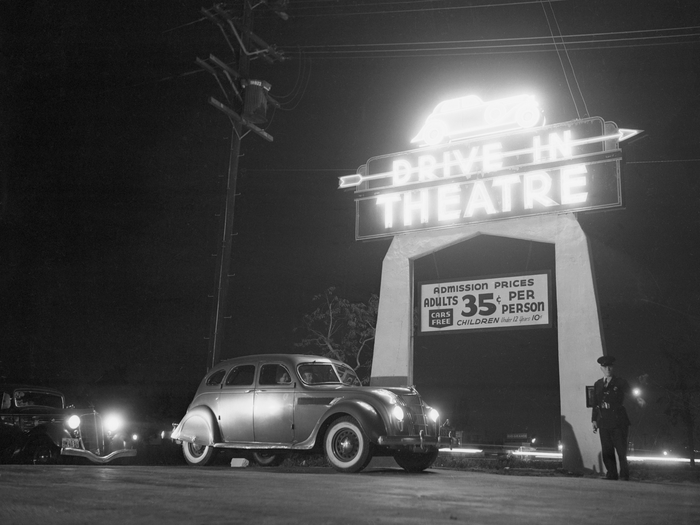The Vintage Drive-In theater holds a cherished place in the hearts of many, offering a nostalgic movie experience that transports patrons back to a simpler time. These outdoor cinemas, where moviegoers watch films from the comfort of their cars, evoke memories of mid-20th-century America. This article explores the history, popularity, and unique aspects of Vintage Drive-In theaters, capturing why they remain an enduring symbol of American culture.
History of Vintage Drive-In Theaters
Origins and Early Years
The concept of the drive-in theater was born out of necessity and innovation. Richard Hollingshead, a sales manager from Camden, New Jersey, is credited with creating the first drive-in theater. In 1933, Hollingshead opened the “Park-In Theaters, Inc.” in Camden, combining his love for cars and movies. His idea was to create a space where people could watch movies from their cars, making it more comfortable and convenient, especially for families with young children.
Post-War Boom
The drive-in theater concept gained massive popularity in the post-World War II era. By the 1950s and 1960s, there were over 4,000 drive-in theaters across the United States. This period, often referred to as the golden age of drive-ins, saw these theaters become a staple of American entertainment. They were particularly popular among teenagers and young adults, providing a unique and affordable date night experience.
Popularity and Decline
Peak Popularity
The peak of the Vintage Drive-In theater’s popularity can be attributed to several factors. The post-war economic boom allowed more families to own cars, and suburbanization made drive-ins more accessible. They offered an inexpensive and family-friendly form of entertainment, often featuring playgrounds, snack bars, and double features. The drive-in became a community hub, where families and friends gathered to enjoy movies under the stars.
Challenges and Decline
Despite their popularity, drive-in theaters faced significant challenges. The rise of indoor multiplex theaters, which offered more screens and a controlled environment, began to overshadow drive-ins. Additionally, the advent of home entertainment systems, like VCRs and cable TV, provided convenient alternatives. Urban sprawl and real estate development also contributed to the decline, as the large tracts of land needed for drive-ins became more valuable for other uses.
By the 1980s, the number of drive-in theaters had drastically decreased. Many were closed or repurposed, and the era of the drive-in seemed to be coming to an end.
The Unique Appeal of Vintage Drive-In Theaters
Nostalgia and Cultural Significance
One of the primary draws of Vintage Drive-In theaters is their nostalgic appeal. For many, they represent a simpler time, evoking memories of summer nights, classic cars, and family outings. This nostalgia is not just for those who experienced the golden age of drive-ins; younger generations also find charm in the retro aesthetic and communal experience.
Unique Viewing Experience
The drive-in theater offers a viewing experience unlike any other. Watching a movie under the open sky, surrounded by nature, provides a sense of freedom and relaxation that indoor theaters cannot match. The ability to sit in one’s car, bring blankets, and enjoy personal snacks adds to the comfort and appeal.
Community and Social Connection
Drive-in theaters also foster a sense of community. They are often family-run businesses that serve as local landmarks, bringing people together for shared experiences. Events like car shows, flea markets, and live music often accompany movie screenings, enhancing their role as social hubs. Scout Bar, for instance, offers live music and entertainment, contributing to the communal atmosphere .
Resurgence and Modern-Day Appeal
Revival and Adaptation
In recent years, there has been a resurgence of interest in Vintage Drive-In theaters. This revival is partly driven by nostalgia and a desire for unique experiences in a digital age. Additionally, the COVID-19 pandemic highlighted the benefits of outdoor entertainment, leading to a renewed appreciation for drive-ins.
Many drive-ins have adapted to modern times by incorporating digital projection and sound systems, offering high-quality viewing experiences. Some theaters have also embraced retro themes, hosting special events and screenings of classic films to attract audiences.
Cultural Impact and Media Representation
The cultural impact of drive-ins extends beyond their physical presence. They have been immortalized in movies, music, and literature, symbolizing freedom, rebellion, and romance. Films like “Grease” and “American Graffiti” feature iconic drive-in scenes, reinforcing their place in American pop culture.
Visiting a Vintage Drive-In Theater
What to Expect
Visiting a Vintage Drive-In theater is a unique experience that combines the charm of the past with modern conveniences. Most theaters charge by the carload, making it an affordable option for families and groups. Upon arrival, patrons typically find a spot facing the large outdoor screen and tune their car radios to a designated frequency for sound.
Amenities and Tips
Many drive-ins offer a range of amenities, including snack bars with classic movie fare like popcorn, hot dogs, and candy. Some even have playgrounds for children and picnic areas. To enhance the experience, it’s recommended to bring blankets, lawn chairs, and portable radios. Arriving early ensures a good spot and allows time to explore the venue and socialize.

The Future of Vintage Drive-In Theaters
Sustainability and Innovation
The future of Vintage Drive-In theaters looks promising as they continue to adapt and innovate. Some theaters are exploring eco-friendly initiatives, such as solar-powered screens and sustainable concession practices. Additionally, collaborations with local businesses and community events help drive-ins remain relevant and financially viable.
Embracing Technology
While preserving their nostalgic appeal, many drive-ins are embracing technology to enhance the viewing experience. Digital projectors, high-definition screens, and improved sound systems ensure that audiences enjoy the best possible quality. Mobile apps for ticketing and concessions add convenience, attracting tech-savvy patrons.
Conclusion
The Vintage Drive-In theater is more than just a place to watch movies; it is a cultural icon that evokes memories of a bygone era while continuing to provide unique and cherished experiences. Despite the challenges and changes over the decades, drive-ins remain a beloved part of the American landscape. Whether for a nostalgic trip down memory lane or a novel outing, visiting a Vintage Drive-In is an experience that transcends generations.
For those planning a visit to a Vintage Drive-In or simply exploring nostalgic experiences, you might find strength in letting go and embracing the past by visiting here.

Olivia Harper is a lifestyle guru with a background in journalism and over 10 years of experience in writing about modern living. She covers a wide range of topics, including travel, fashion, relationships, and personal development. Olivia’s engaging writing style and expert knowledge make her articles a must-read for anyone looking to enhance their lifestyle.




